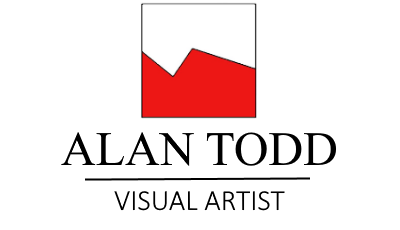CHRONICLE
For as long as I can remember the grid and the enclosing box have been at the base of everything I have created. There is something satisfying about grid forms and anything that brings them into being like piles of bricks, stacked timber, paving stones, rows of houses, skyscrapers and particularly film negatives and storyboards create a sense of order that I have never found in nature. I am a city dweller at heart. All of my explorations in the theatre were about a narrative that existed in squares and rectangles. I divided the stage in my mind, and in reality, into areas and viewed it from above. Dancers were like pencils or brushes that moved between and through the spaces. I was essentially creating city environments and peopling them. All of the recent paintings and drawings have this structure beneath them but then so do the few that remain from the 1980s when I essentially stopped painting in favour of sculpture and didn’t paint seriously again until late 2017. The three paintings stem from two sources. In 1984 I visited Rockhampton for the first time and was impressed by the sheer volumes of water pouring down the drains after a severe downpour. The city and its streets are the grid and the water the organic forms. A year later I as in Swan Hill and called in at the blacksmith’s shop. What impressed me were the endless metal forms hanging from the ceiling. Forged from iron, they no longer had any use of identity other than as forms. Again, the grid structure was the town and the metal forms the cured lines and tones.
The grid drawings of December 2015 combined rectilinear and more organic elements. I was interested in the way the grid lines themselves could be manipulated using varying pencil pressure to suggest a fluid depth. At times the lines disappear completely. The grid consequently comes in and out of focus. Interwoven are lines of varying strengths that alternately compress or open out the space. Where they cross the boundaries of the grid they suggest something woven like wool or cotton strands but essentially these ideas are more attuned to city squares seen from above and the movement of people. I once spent a morning at Grand Central station in NY observing the way commuters created patterns as they traversed the concourse avoiding each other and impediments to their progress.
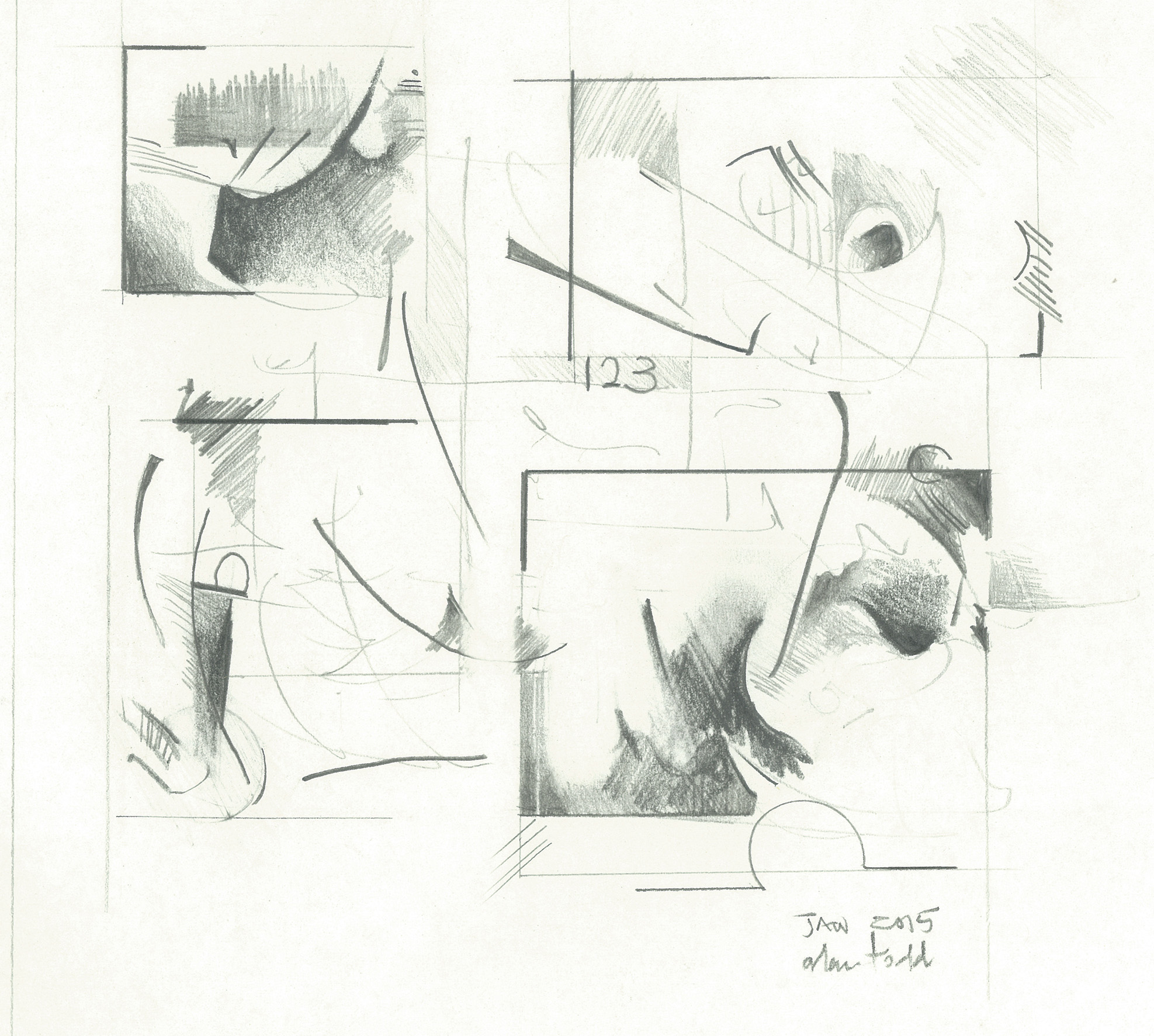

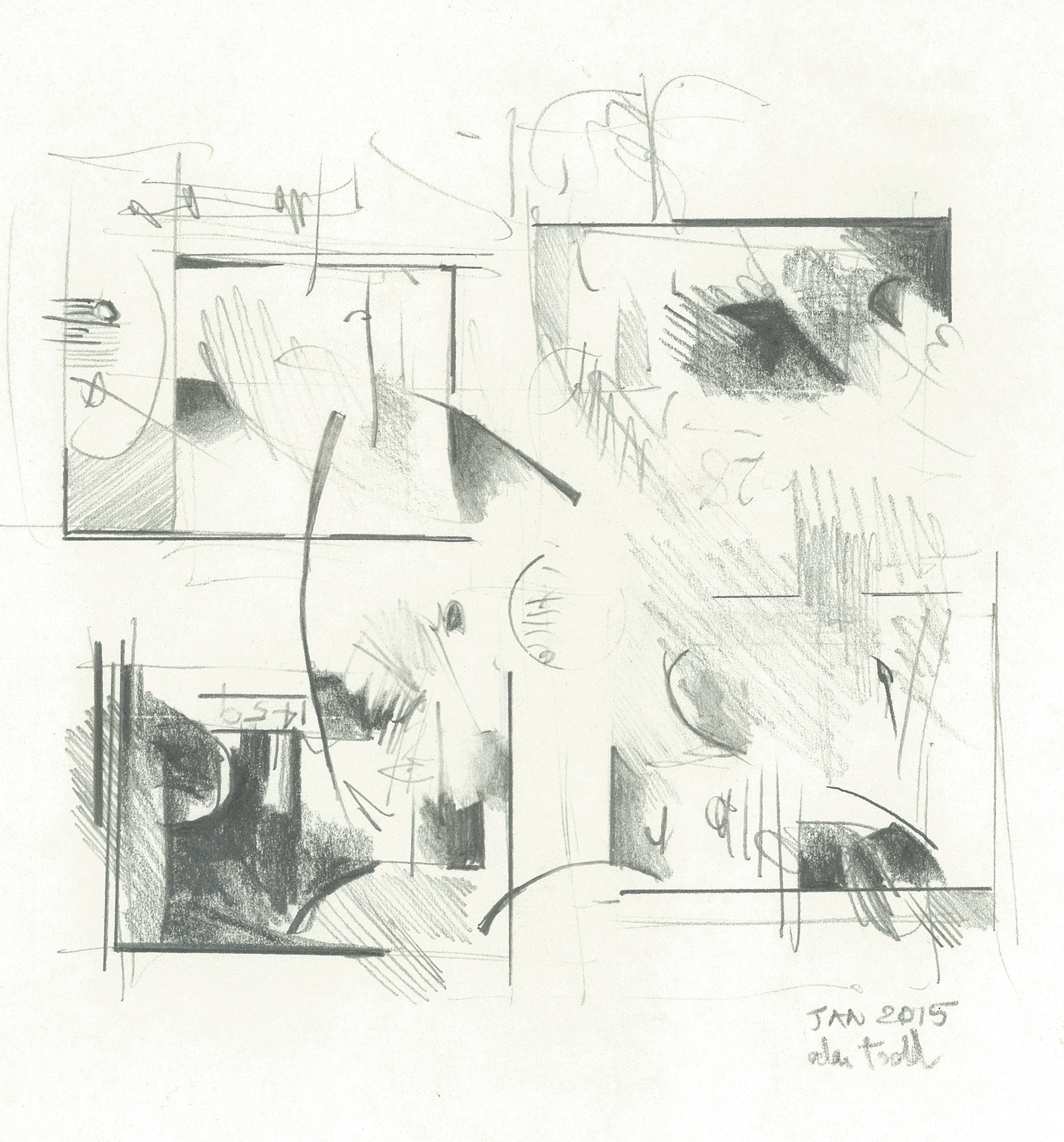
I was pleased with the way these evolved. While the underlying grid structure was still evident it was not the dominant factor. further eperiemnts with single frames followed and while they all possessed something interesting , on their own they were taking the idea in another direction. Loosening the forms and returning to a grid was more pofitable.
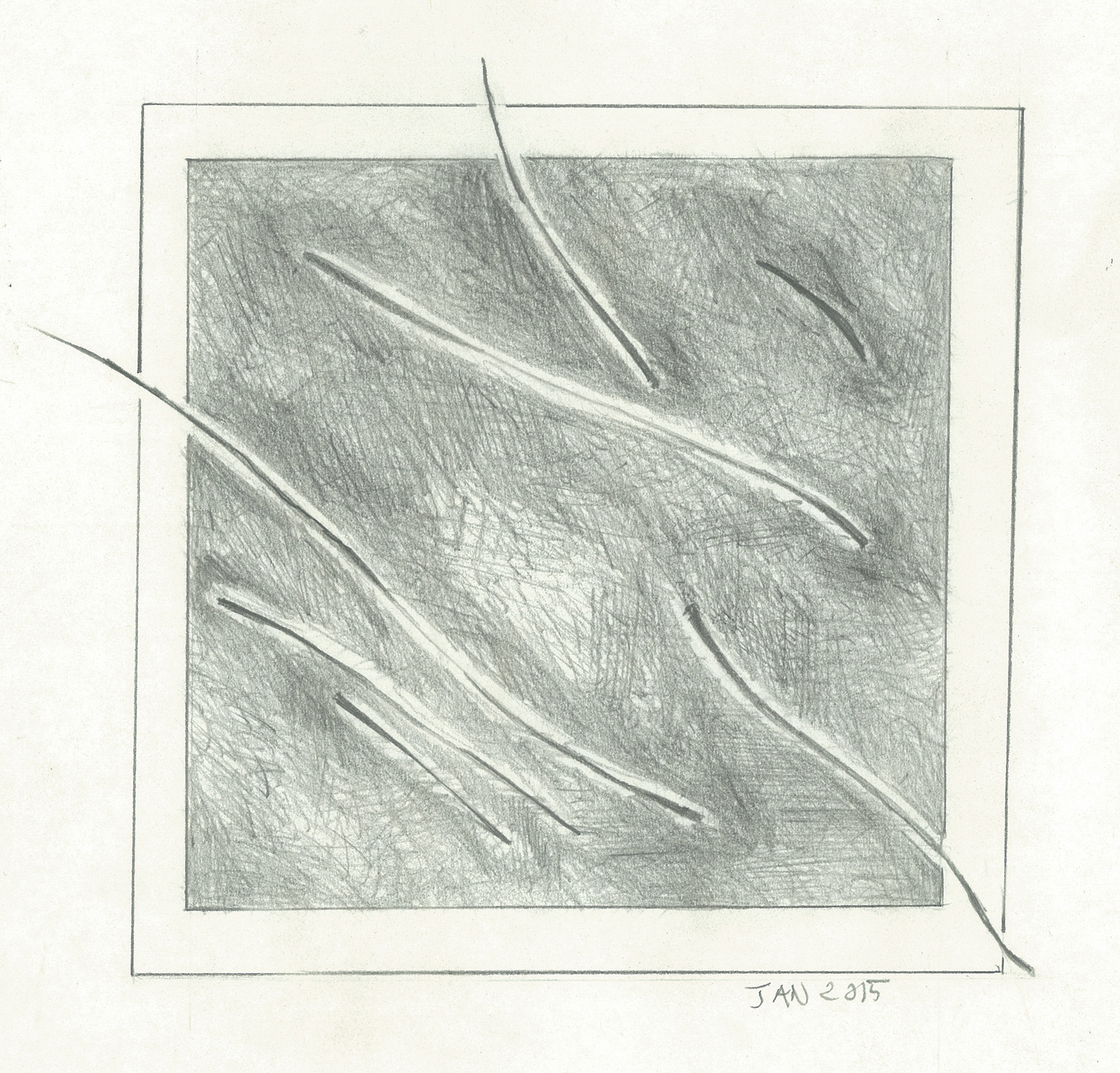
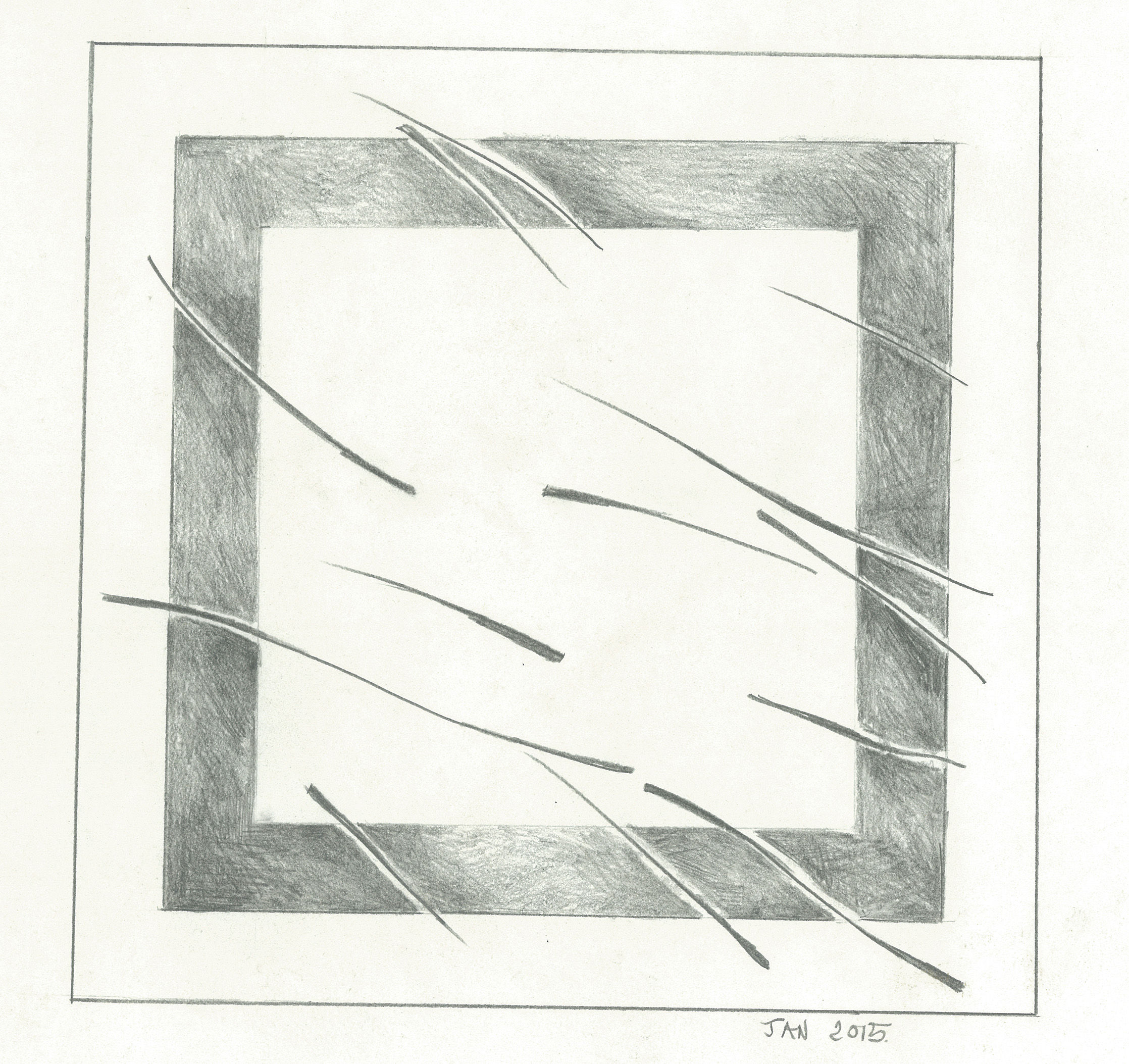
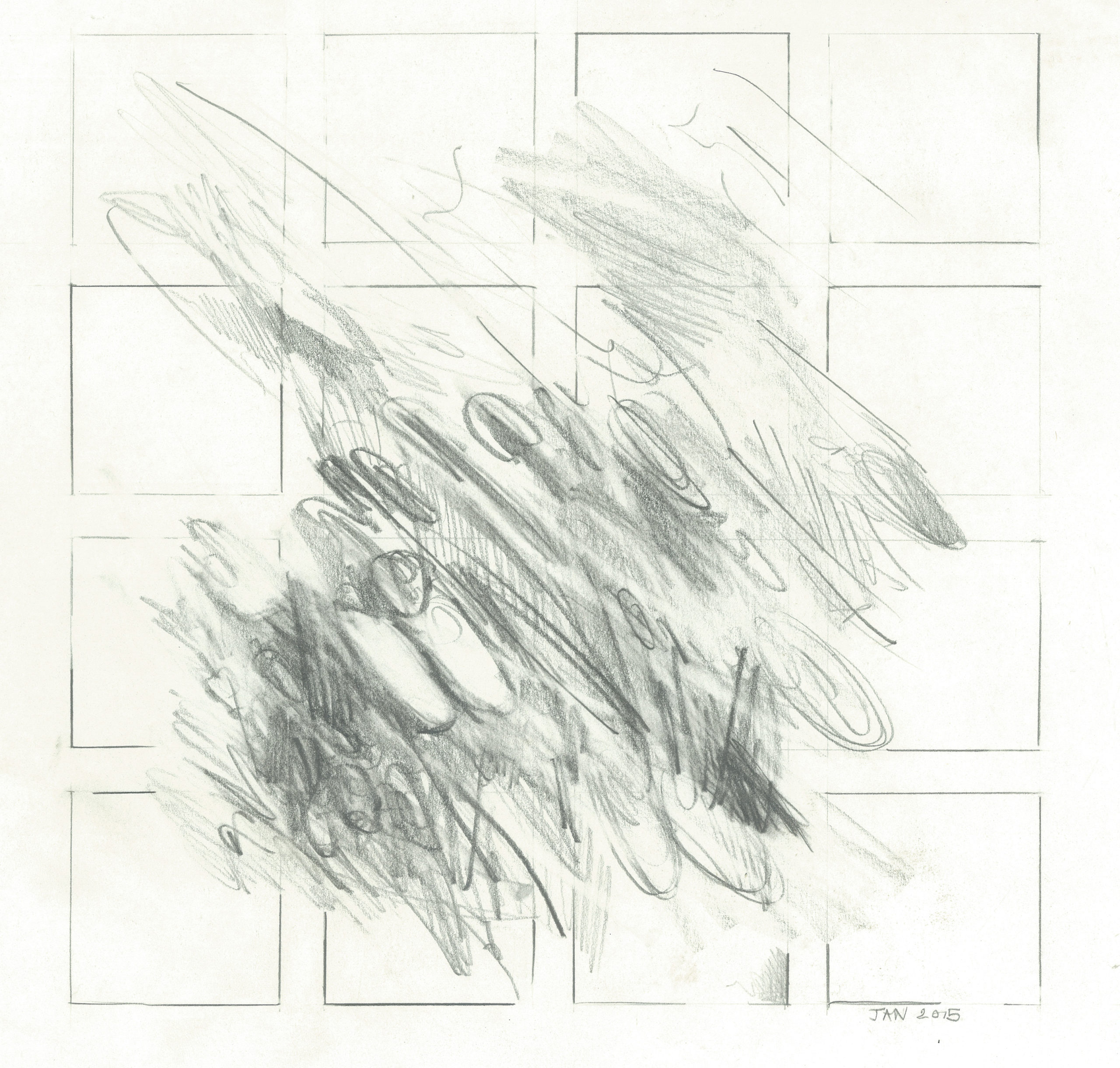
This same idea came from observation in my garden. Attempts to tame nature in the form of outbuldings, stakes, chicken wire and paths failed continually as plant-life went its own way. The addition of shifting light created grid-like patterns throughout the day.
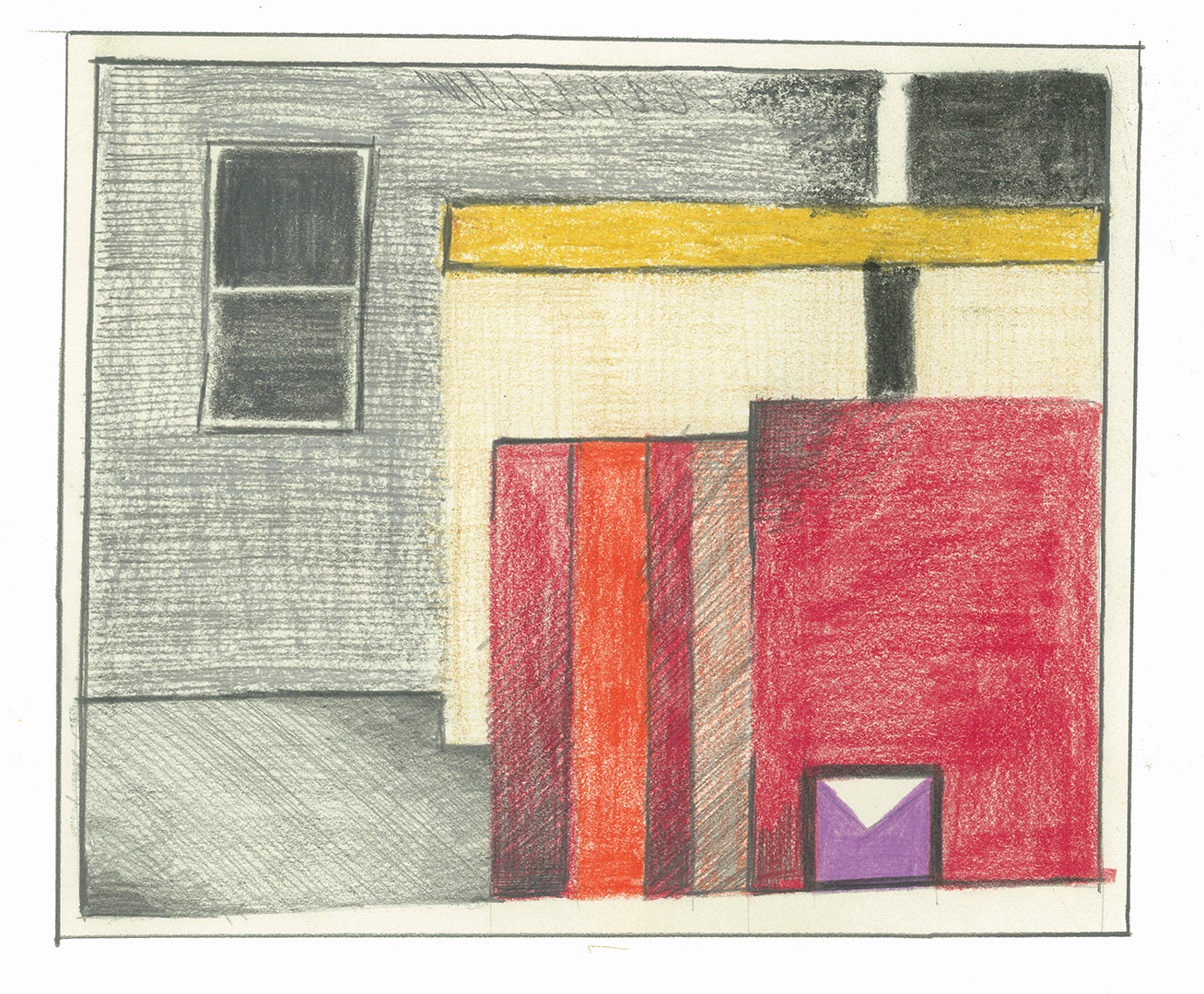

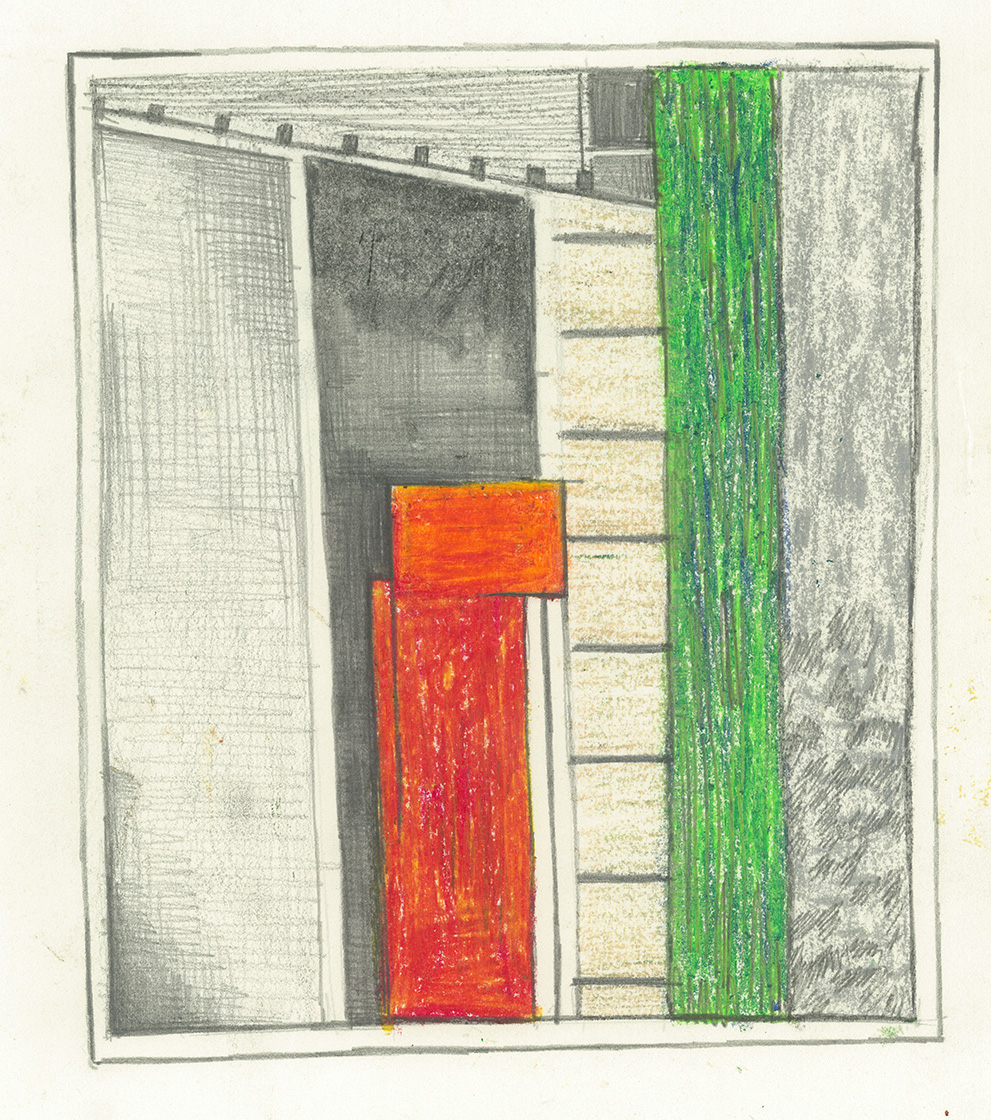
Another way into this idea was to lay down the organic lines first. Using coloured pencils I intuitively created texture and flow over sheets of paper. Cutting up these into squares and reassembling them into a grid by turning each one gave me unexpected variety. Drawing over the top linked across the grid lines creating a layer not envisioned in the early lines and textures. There was an added dynamism.

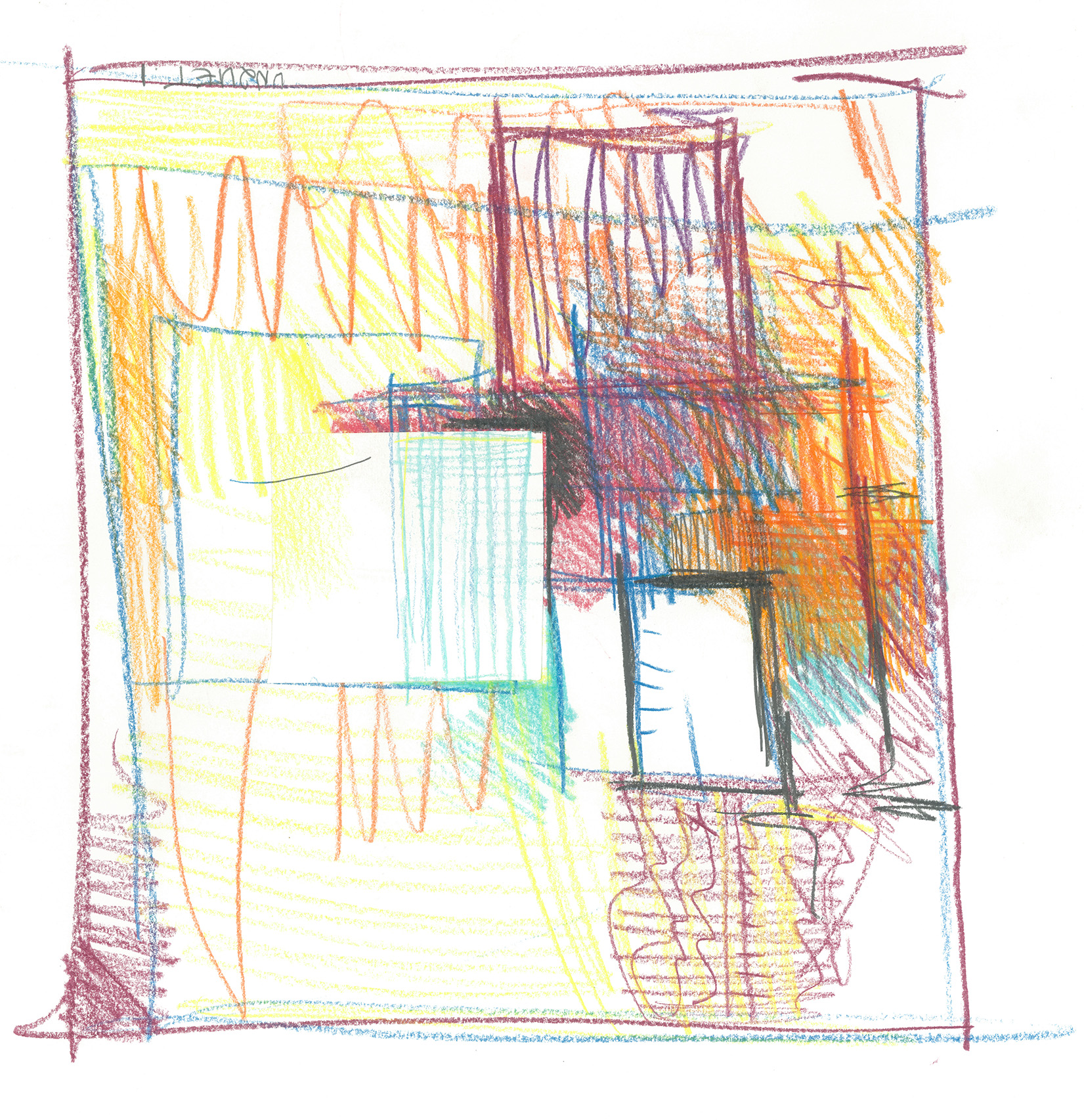
Feeling as though I needed to get back to drawing in a less abstracted way, I decided to go to life drawing classes. It didn’t last long. I could always draw figures and the poses certainly weren’t challenging even with all my efforts to make them so.

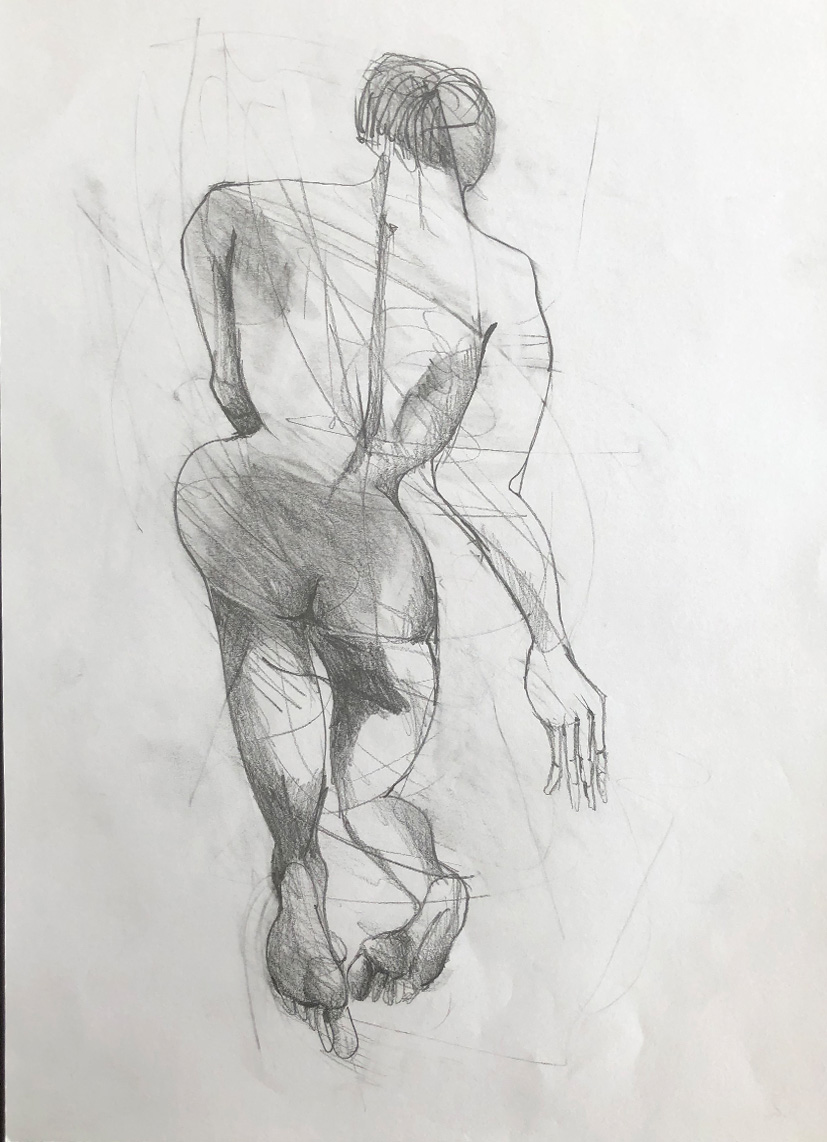

Feeling the need to get back to the grid, I marked out long rectangles on paper, redrew the loose figures without copying the originals and put in dividers that suggested what I had seen so often in urban areas where people could be cut off by verticals as they entered and left shops. What followed were ever longer versions. A range of techniques to add texture and tone were invented. I felt that these were successful although a long way from where I had begun.
Transfering this approach to painting proved again to be a challenge. Taking each of the drawn divisions/sections to be a separate canvas I soon had two paintings over five metres in length. One was the equivalent of a positive and the other a negative. What they were becoming were versions of the film storyboard – linked frames to explain a narrative. Two more followed, shorter but not by much. The narrative in all of them suggested that the audience had to walk from left to right. To slow down the process and add an element of time, I added words which had to be read. Unlike dialogue in a film, these words were more like poems influenced by Greenaway’s use of language in a Walk Through H. They suggested a journey but without a beginning or an end. The use of only black, white and blue greys made for a strong pattern element and I didn’t want the words to dominate through being too obvious. Using a white gel pen and a series of letter stencils allowed the words to exist as outlines without suggesting handwriting or being so bright that you saw nothing else.



Eventually I separated the two biggest paintings into their separate canvases and treated each one as an entity. While there is still the combination of image, pattern and words, there is no sense of a continuous narrative.
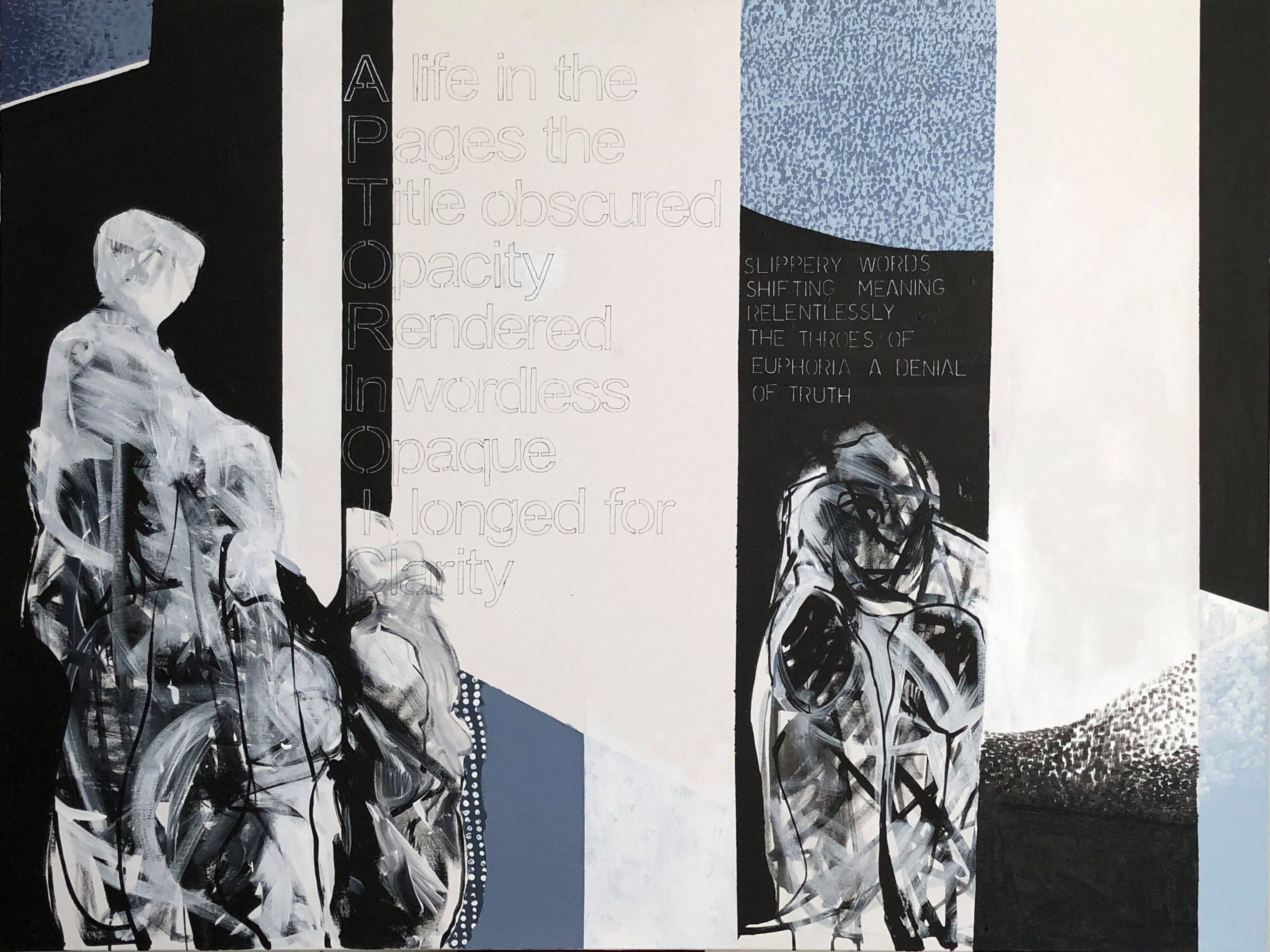
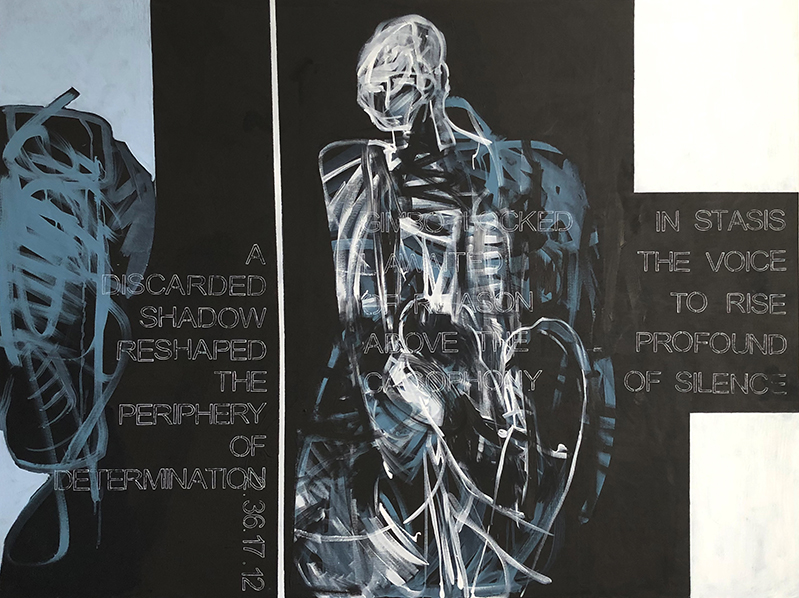
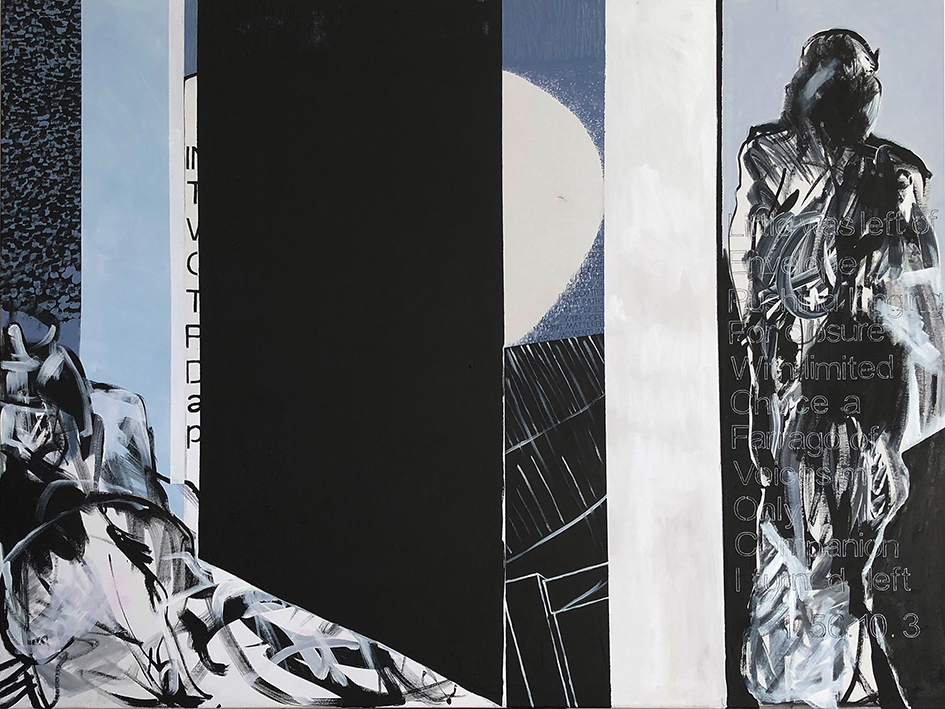
Concern with written language came to dominate the work of the next few months. I was trying to reconcile what I could see in so many films. The image on the screen often had nothing to do with the dialogue. Using versions of the loosely drawn figures, I created flattened environments in which they could live. The figures still related to sections that cut them off in interesting ways but the words became increasingly more important. At this point I read about elderly Japanese found dead in their city apartments having lived and died alone. There were a lot of photographs that compressed the space even more and were taken at odd angles. It struck me just how much they resembled what I had been drawing. One photograph was of a corpse that had turned transparent, still seated upright in a chair where the person had died. The bones and fabric edges looked very much like my figures and the way lines overlapped and wove together to suggest form.
What words to use became an increasing problem. I tried using fragments of conversation, messages left on an answering machine and a list of words I found suggesting psychological states that were essentially inexpressible. Nodus Tollens, Exulansis and Jouska with explanations were hand painted in white on the surface. The effect was over-bold and disturbing. After I had worked on eight of these large canvases, I abandoned the idea. They were becoming too much like illustrations explaining their own existence instead of exploring the divide between image and words.
All but one of these paintings was painted over and the words removed to be replaced by timecode in reference to the way individual frames are marked to aid with film editing. You can pinpoint any frame in recorded footage. The odd angles and compressed space of the Japanese photographs found their way into the design.
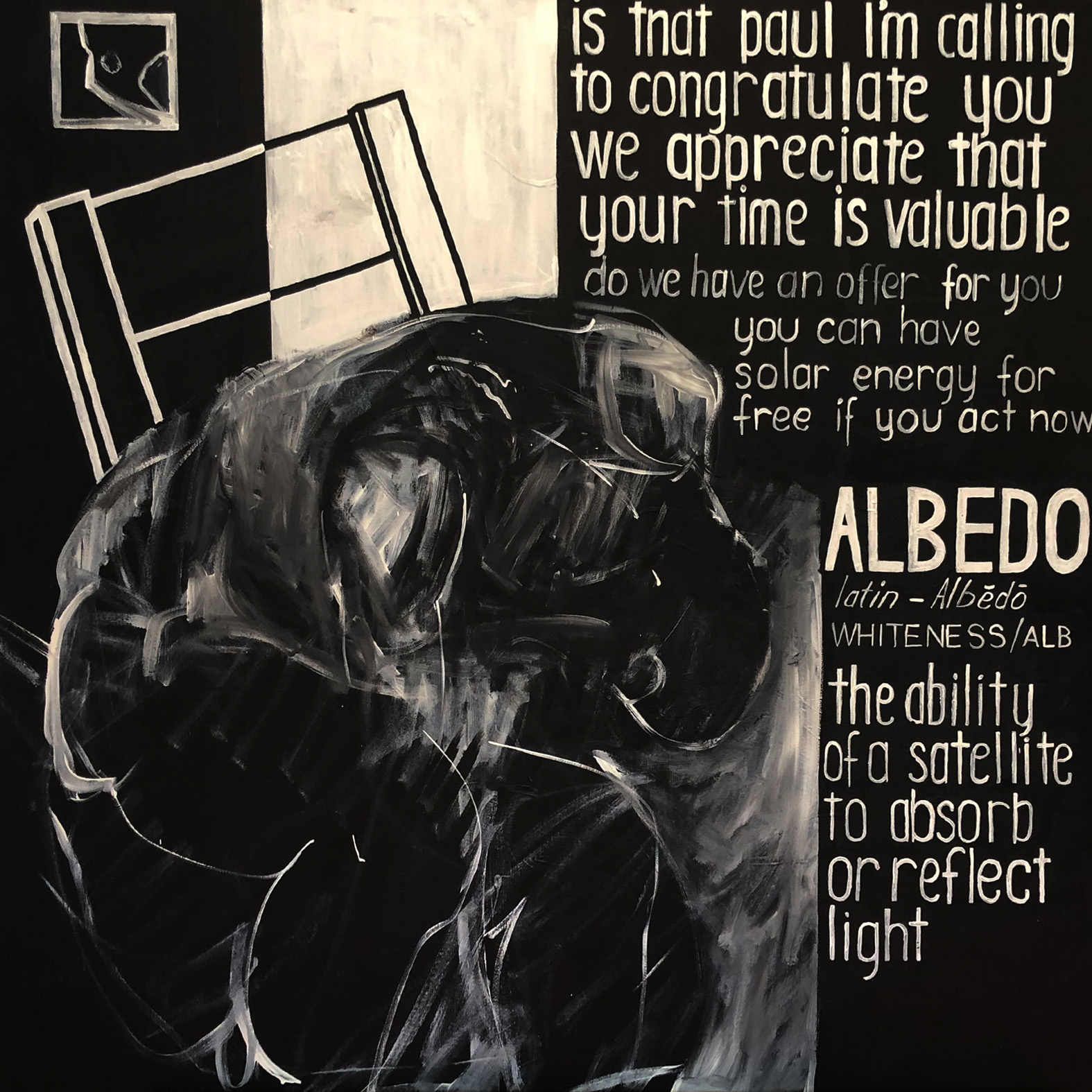

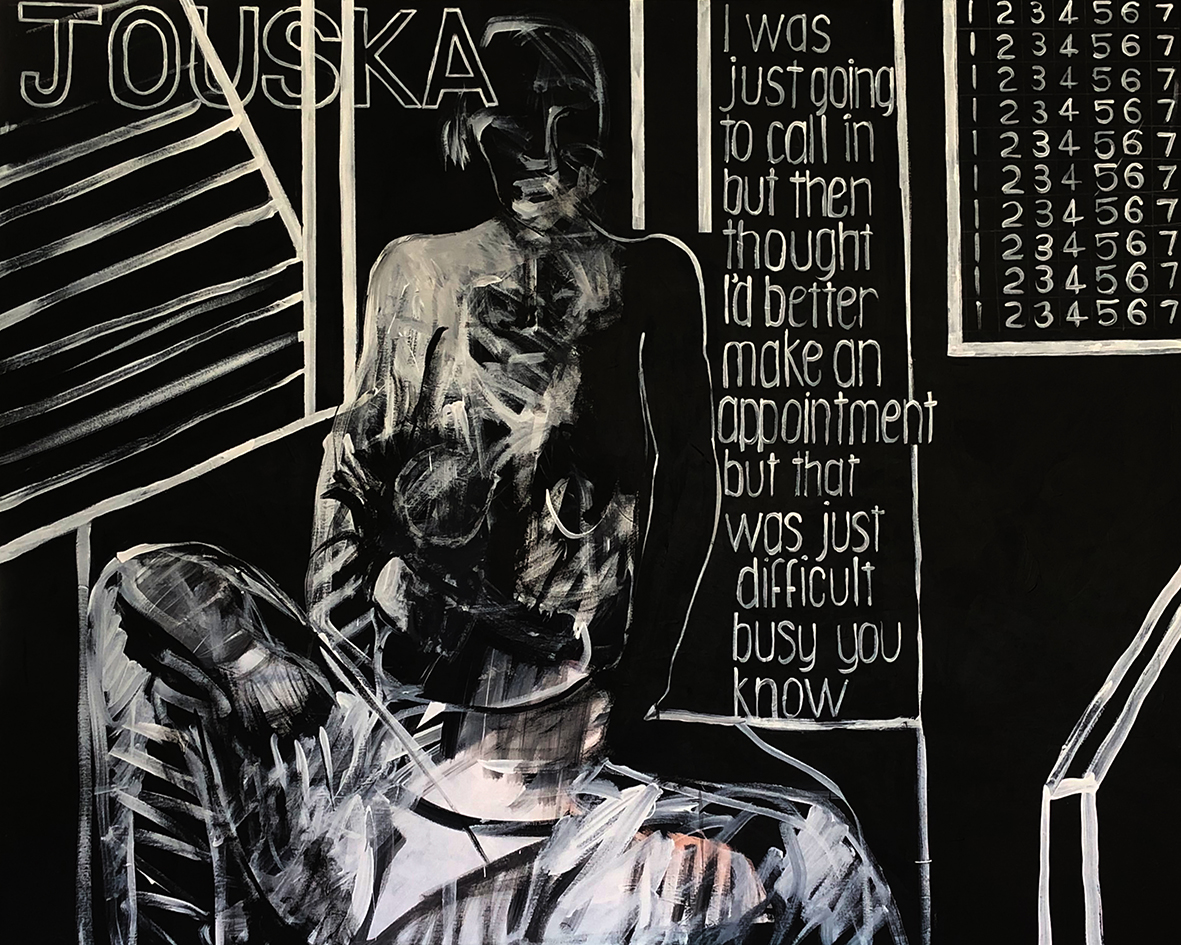
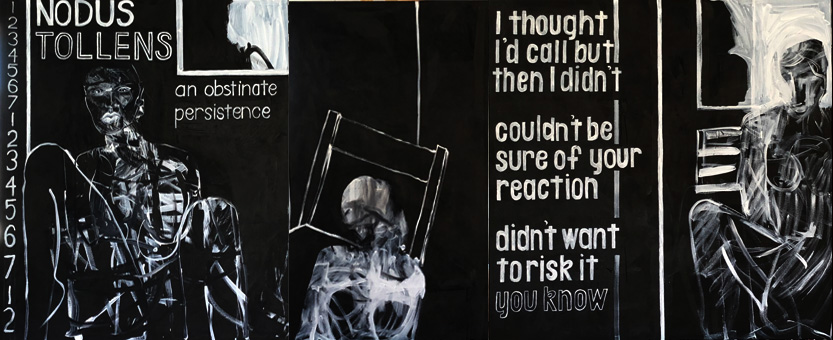
A great deal of experiment ensued where I was creating pseudo storyboards. I had ideas of repetition whereby one frame was repeated but as interesting as these were I put them aside to pursue later
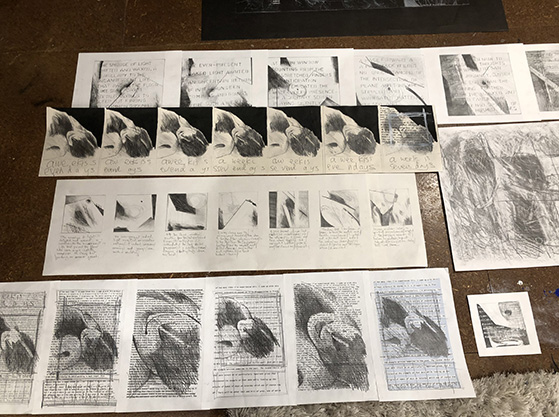
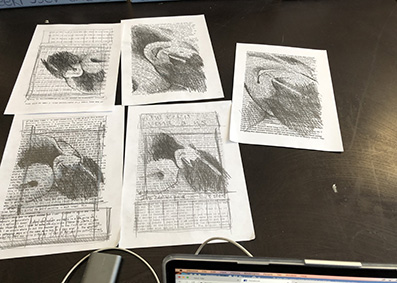
This was something I recognised in the work of Peter Greenaway. As an artist he was a film maker and as a film maker he was an artist. The preparatory work of writing and drawing over scripts to say nothing of all the maps he created for H, fascinated me. Everything I had done to this point suggested that the single frame with words was the way to go.
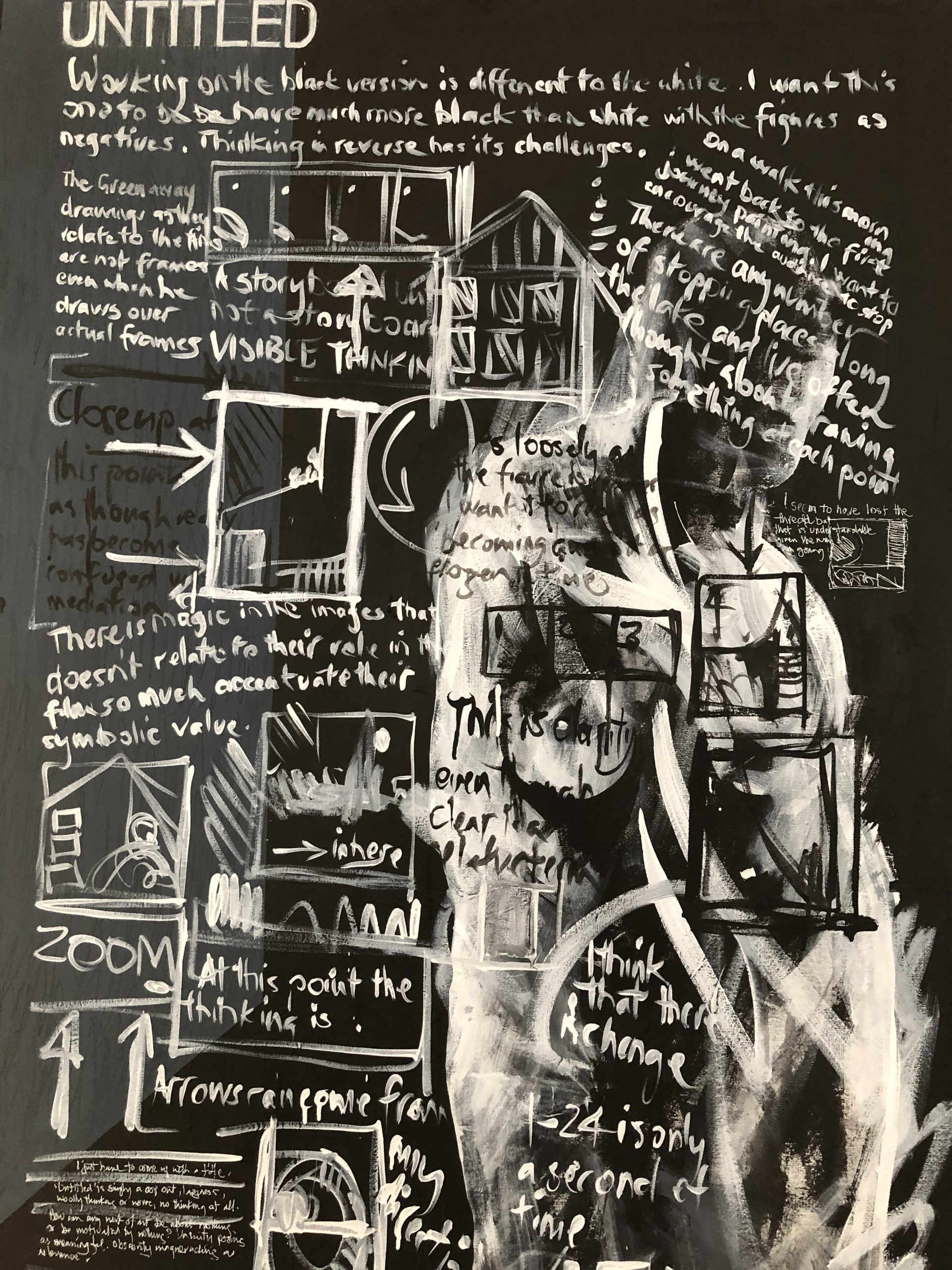
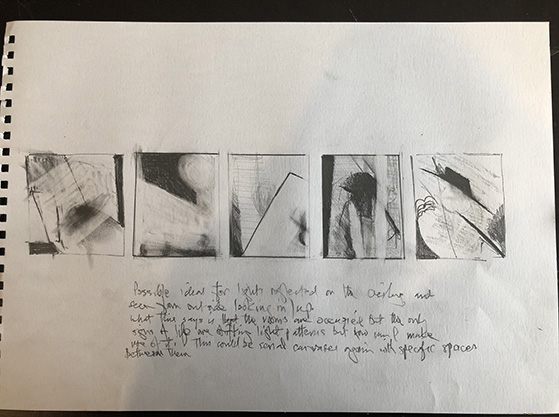
Thursday February 19 2021.
The two paint/collages derive from this idea of the past. In covering a previously existing painting, traces of the colour remained beneath the black paint. I deliberately accentuated where the paint would cover and where it would not by layering on impasto medium unevenly. Drawing up the grid with a white charcoal pencil isolated coloured areas and textures within boxes. To try and realise the idea of a narrative I took a small brush and drew gestural lines in white paint from one box to another as if making a connection. Needing to differentiate areas to relieve the overall darkness I cut up several old paintings consisting of words and shapes and applied the bits as collage. In some places the bits show the box boundary. In fact, in the second painting I put all of the the grid lines in with masking tape and black paint to approximate the divisions in the negative bag rather than just the horizontal strips. What would have been clear areas between the negatives became solid – a reversal of expectation. Writing over the top in white gel pen allowed me to add directorial directions – I felt that I needed more of the text but it may be overkill.
Overall I don’t think the paintings have the clarity I imagined.


This is going to sit for a while. There are 20 smaller versions that might be individually mounted but i’m not aure as yet. I’m going to need something smaller for the upcoming exhibirion.



In continued experiment to combine text and image a drawing of a Spitfire pilot evolved into these three paintings. THey are as loose as I can paint, basically drawing with paint and overlaying lines. Remains of words asppear underneath like after thoughts or history. This all goes back to analysing films where often the picture on the screen and the dialogue have nothing to do with each other but coexist in the same space. I like the idea of the enigmatic quality.
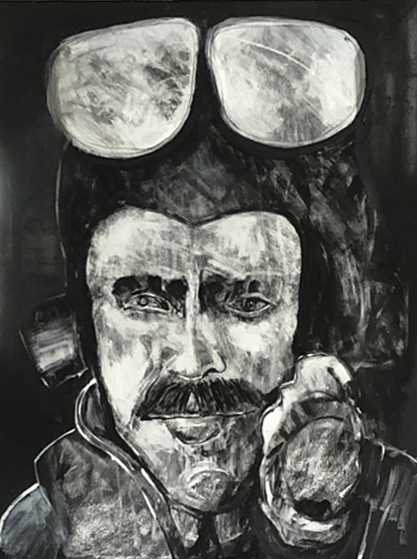
March 2021
Went and lsitened to a talk by Godwin Bradbeer about the technique used on his large faces. Essentially he coverd the pper in chinagraph nd rubbed in crushed black psstel. hat struck me from what he was saying was just how much we had in common when it came to drawing. When I got home I thought i’d experiment. Took a black painted canvas and created a chalk and conte surface roughly the shape of a head, sprayed it with fixative. I don’t have chinagraph but the surface will behave like sandpaper when I work over the top. Bradbeer used crushed black pastel but I don’t have any and nor do I have charcoal. When I applied black acrylic over the top of white I liked the effect but I wasn’t trying to create a face. This is very different. The spontaneity will be quickly lost – something else he talked about in relation to reworking a drawing some time later and the fear students having of losing that initial burst of creativity as though it is god-given. I know what he means but reworking things has never bothered me.
Have to decide now how to draw this oversized portrait. In the painted versions the eyes were solarised [and the lips in one].
The chalk is behaving like paint pigment and creating greys. Not what I wanted but I’m making use of it. Portraiture was never my thing. The gaunt, haunted look is there. The eyes aren’t right yet. In the drawing I did there was more of a stare of defiance rather than resignation. I don’t see these as portraits per se any more than Golub’s work is about individuals even when his faces are quite specific. The idea of ‘I think I can make it’ is still there minus the words. Could there be another of these that incorporates the words without turning it all into an illustration or a poster? If the words were an entirely different medium like neon tubing they would reflect more of the current trend for sayings that could change your life. The personal note of optimism becomes an impersonal advertising hoarding. The pilot lives on in the memory of a generation who know nothing about what he did or why, or cares and a private moment becomes a case of inspirational exploitation. Is that what I’m aiming for? In the paintings the world around him has been reduced to patterns and disjointed flat planes which is a reflection of what I first saw in the kodokushi photographs – death reduced to a non-event, a private moment lost to the world and recorded via a photograph well after with all of the foreshortening and odd angles provided by the camera in a confined space. Unreality approximates reality and falls short.
After two versions of the pilot portrait i’ve given it away.
THE IMPROBABLE MOMENT
As a way of conveying a version of reality, the storyboard, which then becomes a film, breaks the moment into a set number of frames none of which it is possible to perceive as. The moment comes and goes. The film positive or negative records only so much information and even the addition of sound and a director’s notes present only a microcosm of that reality. The painted surface is no different and we accept both it and the film as representing the phenomenal moment even when we know just how improbable it all is.
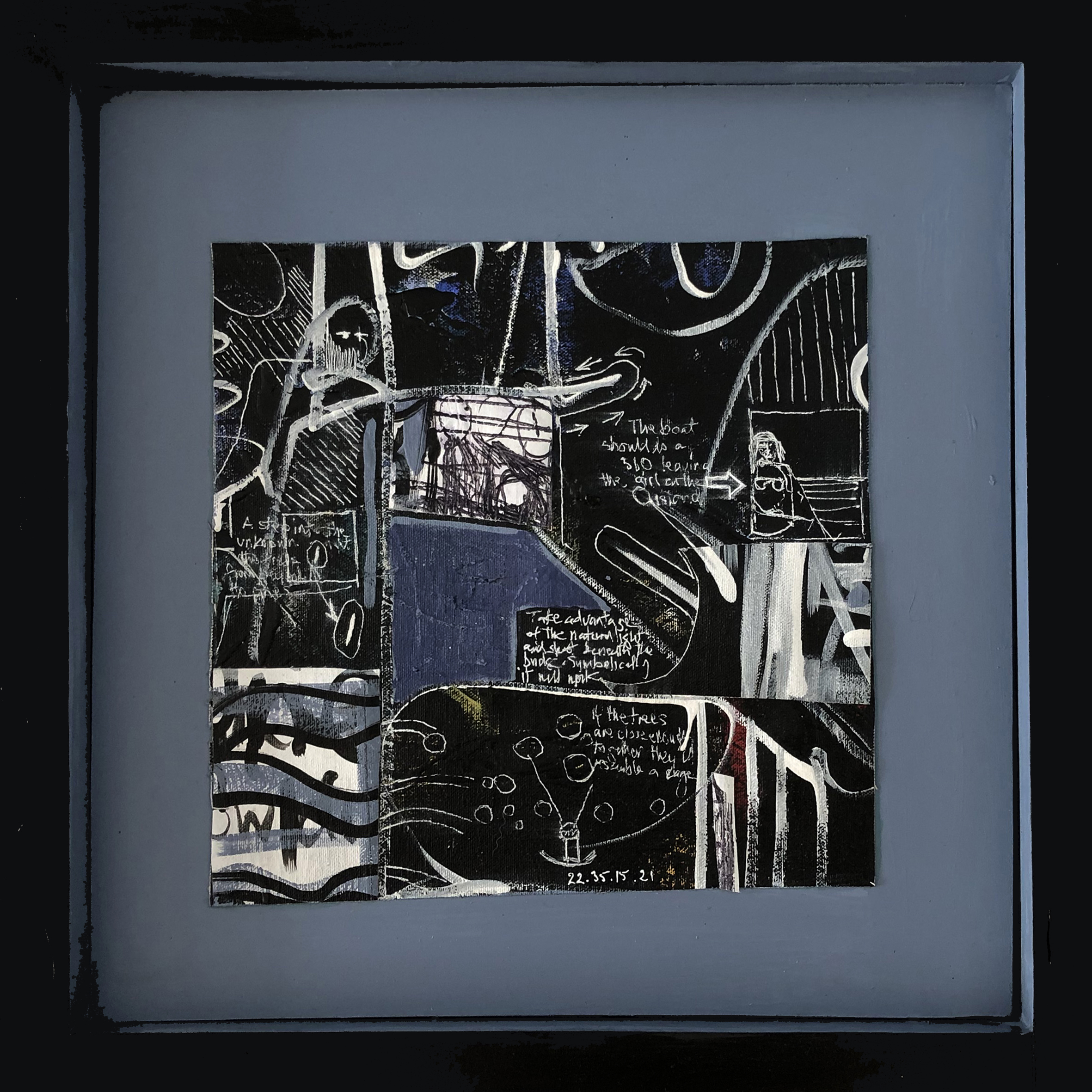
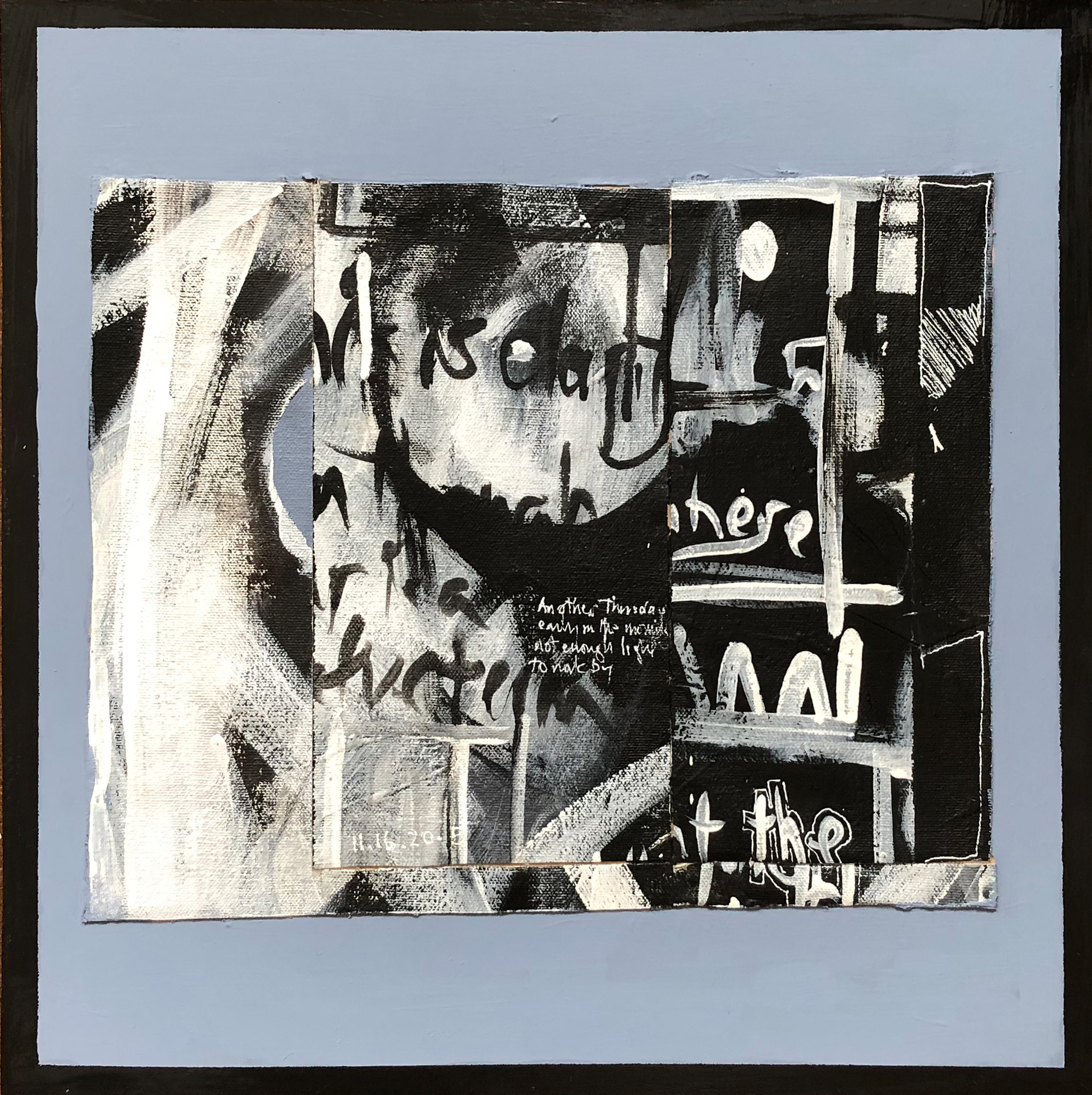

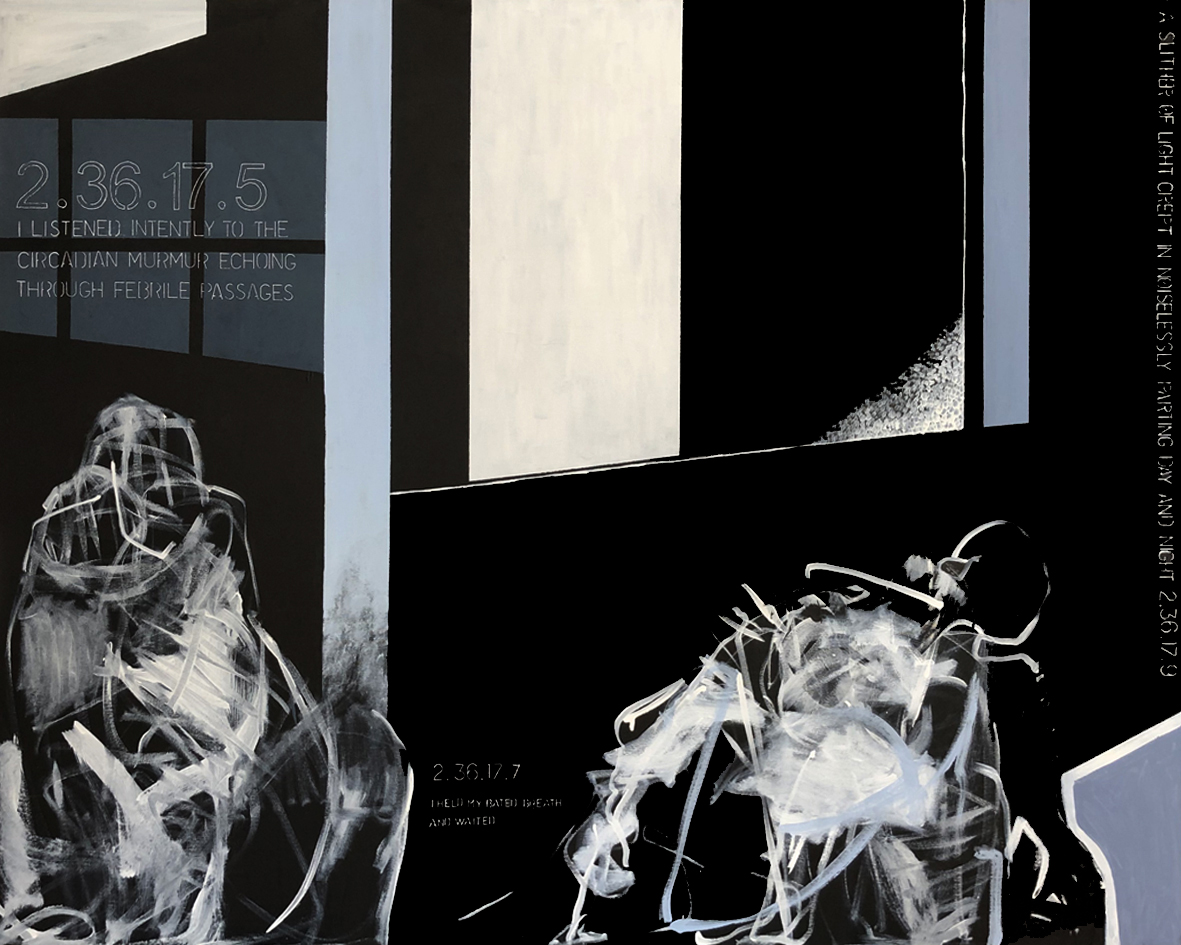
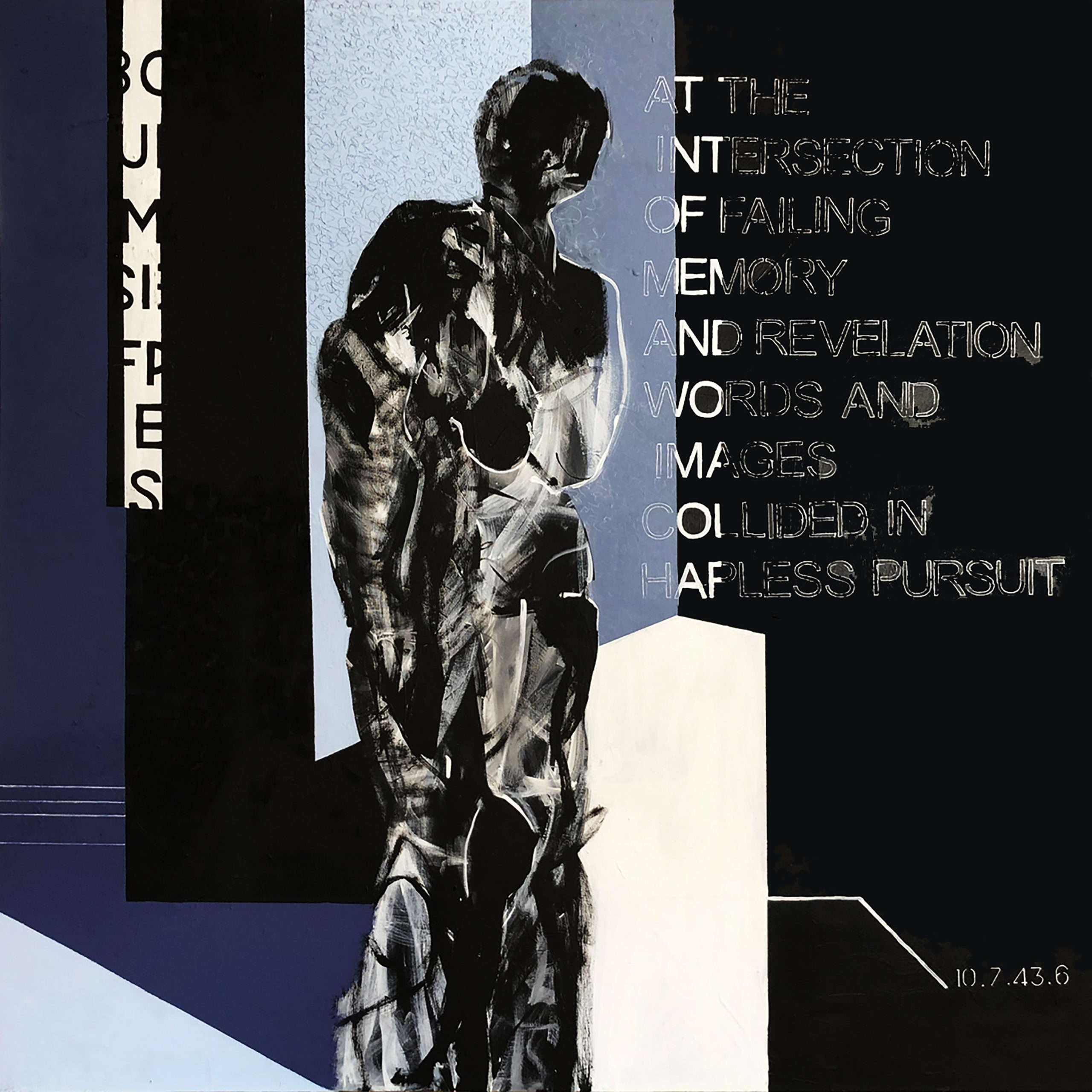

I have always liked grids, both as frameworks and as structures in their own right. As a compositional device the grid is everywhere, whether the artist is consciously using it or not. The accent on a horizon in landscape painting, divides the surface into a grid of two parts but every time a horizontal or vertical element divides the picture plane, a grid is at work.
From Renaissance perspective to Mondrian and Malevich, the grid has been a device of control not necessarily based on mathematics in a deliberate sense, but more that humankind seems to need a way of applying a controlling, man-made system to the seeming randomness of nature. That isn’t to say that nature doesn’t have its grids, from spider’s webs to crystal structures but that painting that isn’t based on the all-over appeal of a late Pollock, relies upon the horizontal/vertical interplay for its rationale. Pollock himself, in a painting such as Guardians of the Galaxy, relied upon just such an interplay but even when it is one of his drip paintings, the rectangular nature of the mounted canvas relates as a module to the wall on which it is hung.
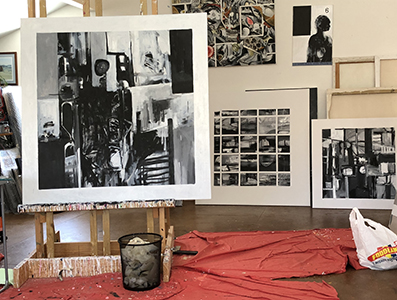
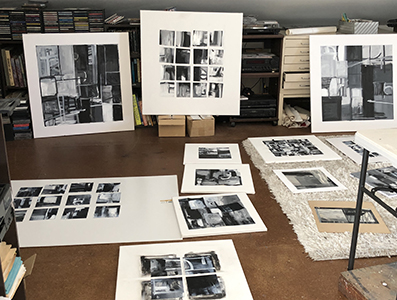

For an artist such as Agnes Martin, grids became not just a mode of organisation but the nature of the work itself.The results can look like a mathematical game on graph paper. As satisfying as it may be to repeat a module as an extendable grid or a uniform textural block, as a means of expression it soon becomes bland and formulaic. By any definition a good painting has a structure but it’s a structure that’s integral to the. What Martin achieved was a light airiness to her work that overrides ideas of blandness.This was achieved by reducing the scale of their divisions so that the overall effect is akin to cross-hatching. As the scale increases we become more conscious of the making aspect.
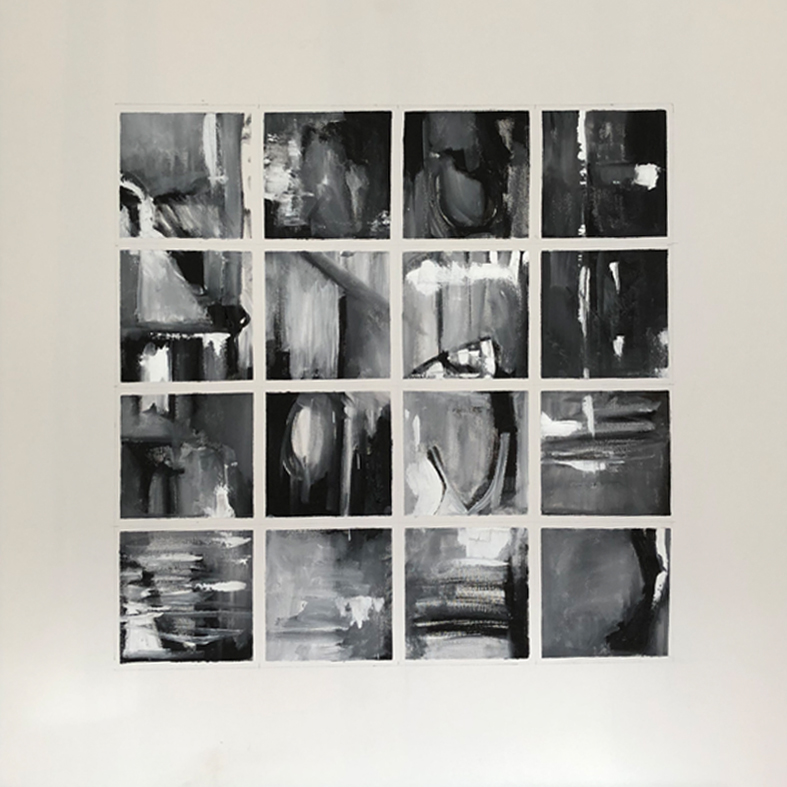

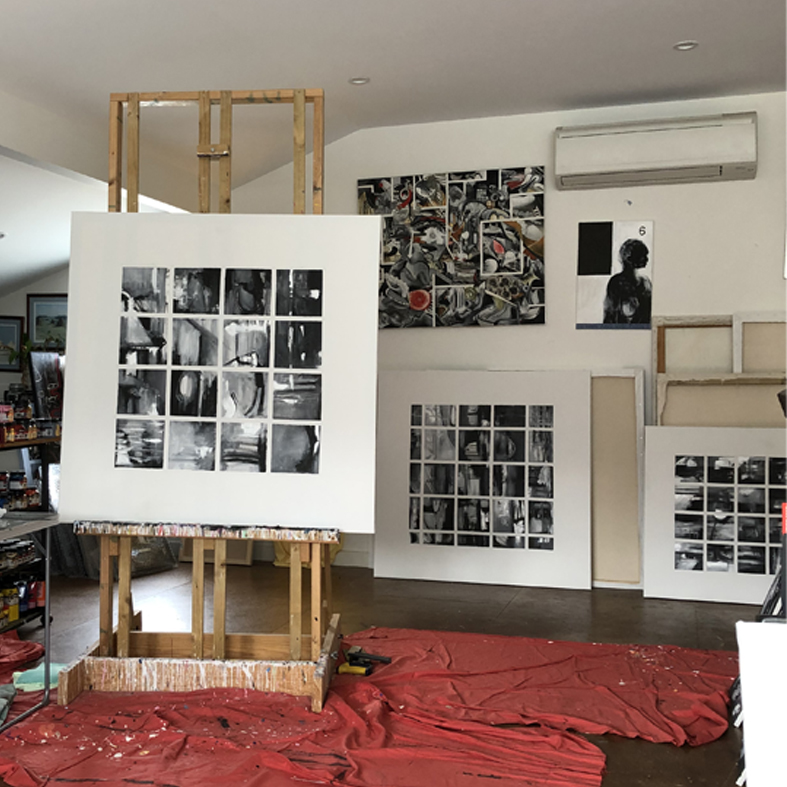
Y
The grid is an extension of the modular unit arranged in a horizontal or vertical pattern and the orthogonal grid is created when the modular units are themselves rectilinear. The assumption can that the network of vertical-horizontal lines become negative elements instead of a positive component. It can also accent the surfaceness of a painting or organise a surface to disperse pictorial elements within its ramework.
The grid used to decentralise the picture surface dates back to Impressionism where the surface consisted of repeated marks. What the grid essentially does is to either fracture or cohere the surface on which it is drawn.


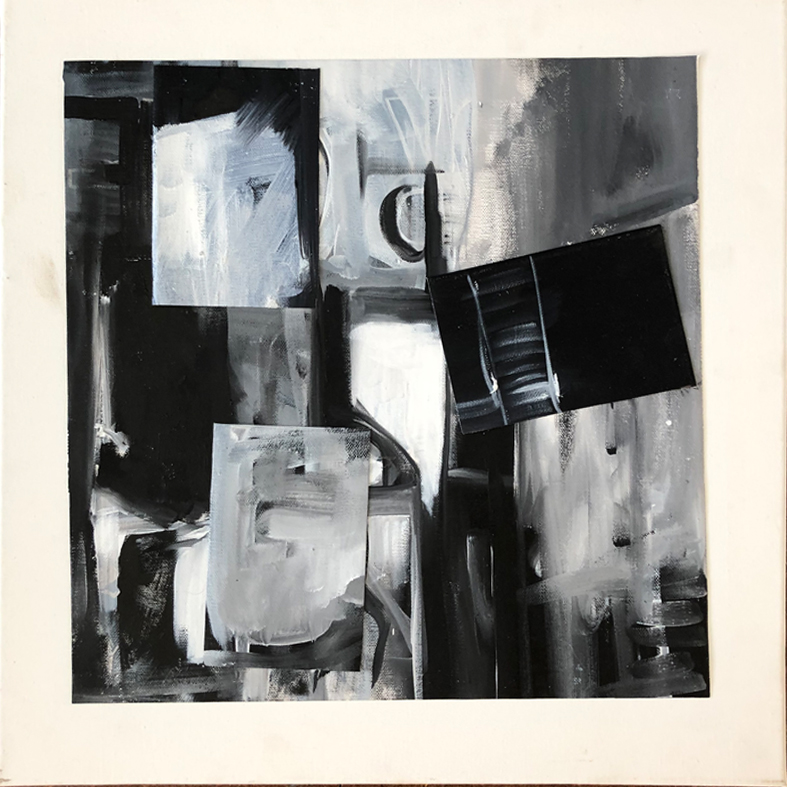
Placing data in separate, but juxtaposed, squares or rectangles reinforces its informational attributes. It suggests that the art consists of two aspects – the framework and the information put into this framework. In Analytical and Synthetic Cubism paintings become containers for signifying elements. So far as grids are concerned, Synthetic Cubism extended the centralised Analytic form so that the grids themselves become signifying elements. Surrealist boxed objects continued this development.
Grids can also make use of the durational implications of repetition, making the work purposefully narrative, that is, describing a brief time span with altered information in each. This kind of cumulative grid has temporal attributess,




.PILINGS, SALVAGED WOOD AND MEMORY
I have always had an interest in wood as a material. The rectilinearity of the previous works led me to P:ort Adelaide once again, a place I first visited in the early 90s. Even then much of its heritage had gone leaving only wooden pilings and bare expanses of concrete. While the4 life of the port had departed, the geometry had remained. However, the history for me was contained in the wood that had survived. The time resilient mooring posts had decayed markedly but still stood as testaments to man’s ability to turn natural materials into monuments and to apply straight lines. I did a lot of drawings of the rotted pilings and their metal fittings treating them as monumental forms. They were and are sculptures in their own right. The idea of salvaged wood persisted into a series of small sculptures that coincided with the death of my father in 2020. He never threw away pieces of wood, partially as a result of his upbringing during the Great Depression but just as much a respect for it as a material. He grew up ‘making do’ and the series Cnversations with my Father were both a tribute to him as a craftsman and a reflection of the lack of communication between us over a lifetime about anything creative.


SENTINELS 2022
Growing up in England promoted a profound interest in pre-history . While wood was rare as a preserved material, stone was everywhere.. The ancient world is full of inexplicable monuments that have outlasted their creators and much as with the pilings of the port, remain as enigmetic and aesthetic monuments.
The wood I chose to use came from building sites all arond me. So much industrial grade timeber was discarded as houses went up. Collecting it didn’t involved much effort at all but it needed to be planed down, nails removed and laminated to give me suffucient size to either carve of use to create substantial forms.
What I was after wass to create forms that have survived but contioan no real clue as to their origins and while they reflect work by a number of 20th century artists such as noguchi and Bourgois, their origins can be traced back to drawings I did a lifetime ago.
Prompted by a negative reaction to my use of industrail timber by a gallery owner who cvlassifieds the works as ‘unprofessional’ I decided to invest in some very good timber in ebony, jarrah and Mahogony. The resultant Night Gardens were necessarily small scale ue to trhe expence of even small pieces of wood but the thinking was still the idea of repurposing [after all they had been cut, discarded and resold via a spacialist timber merchant] and combined with laminated platters from IKEA gave me a varoiety of colours and textures.
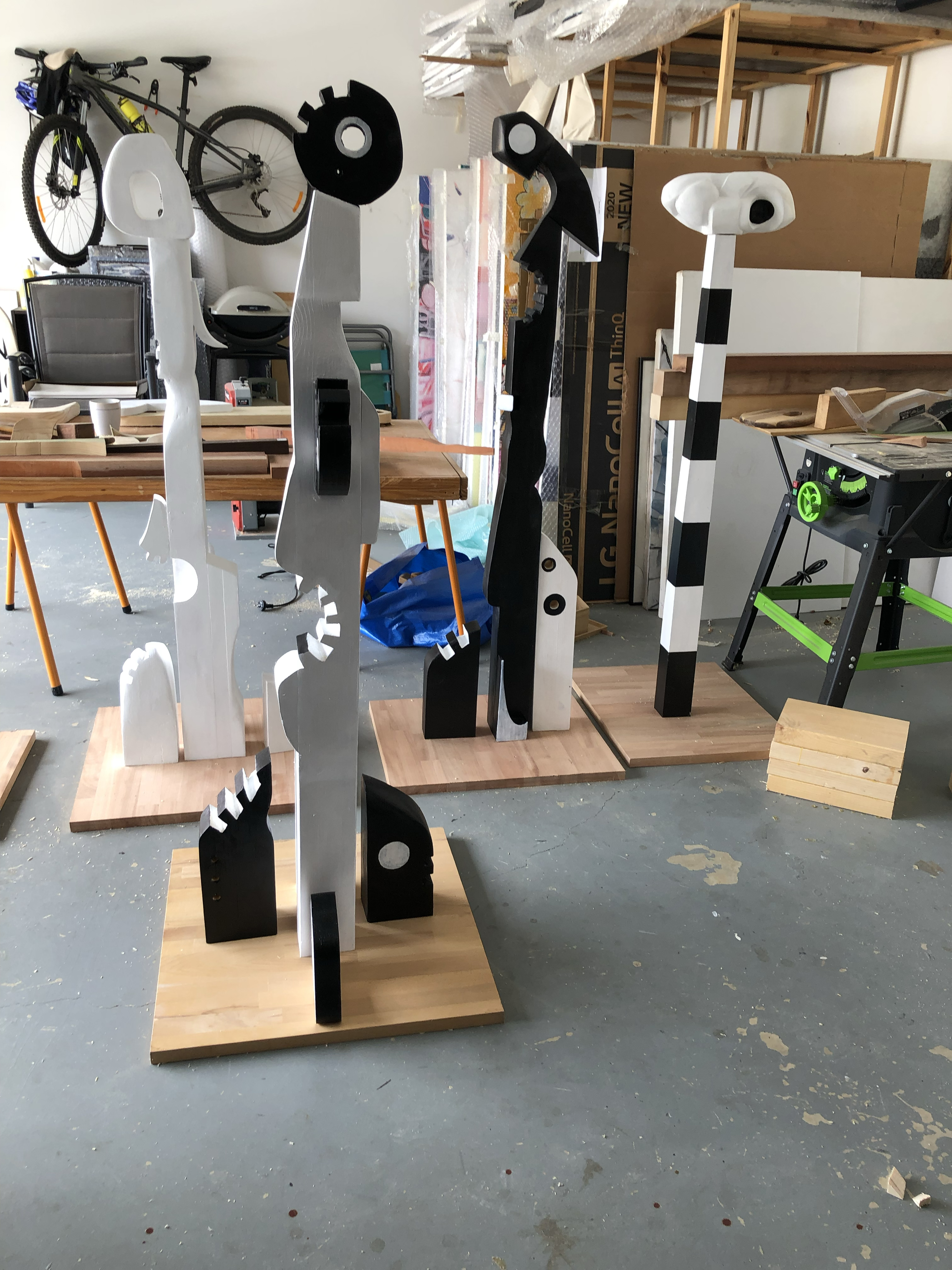
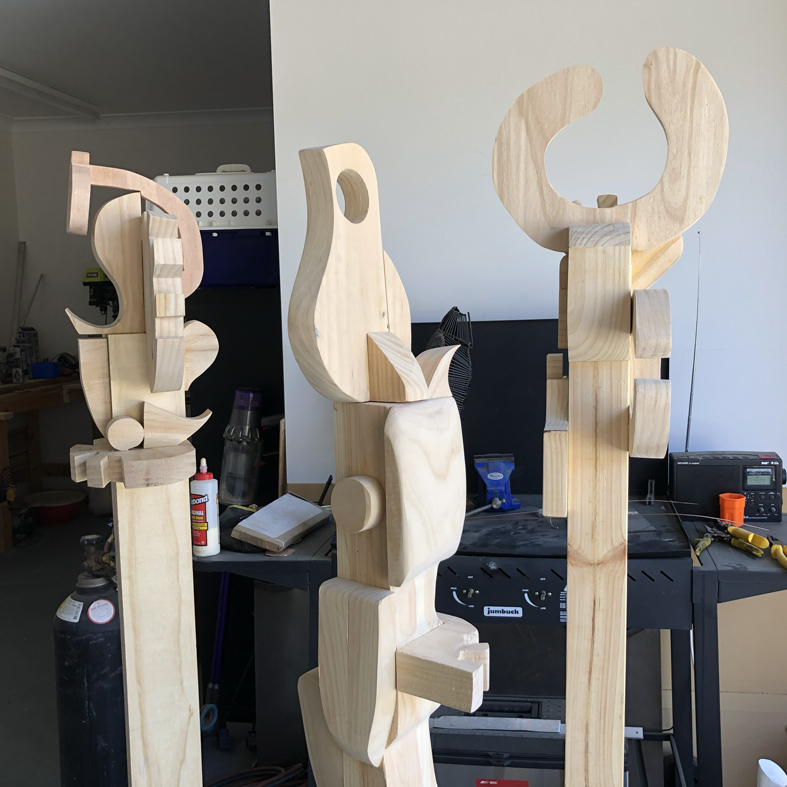
NIGHT GARDENS
Moving on from salvaged wood I bought some exepnsive timb er in mahogony, jarrah and ebony which was comboned with repurposed laminated platters from IKEA.. The variations in colour and texture sugggested gardensa.



